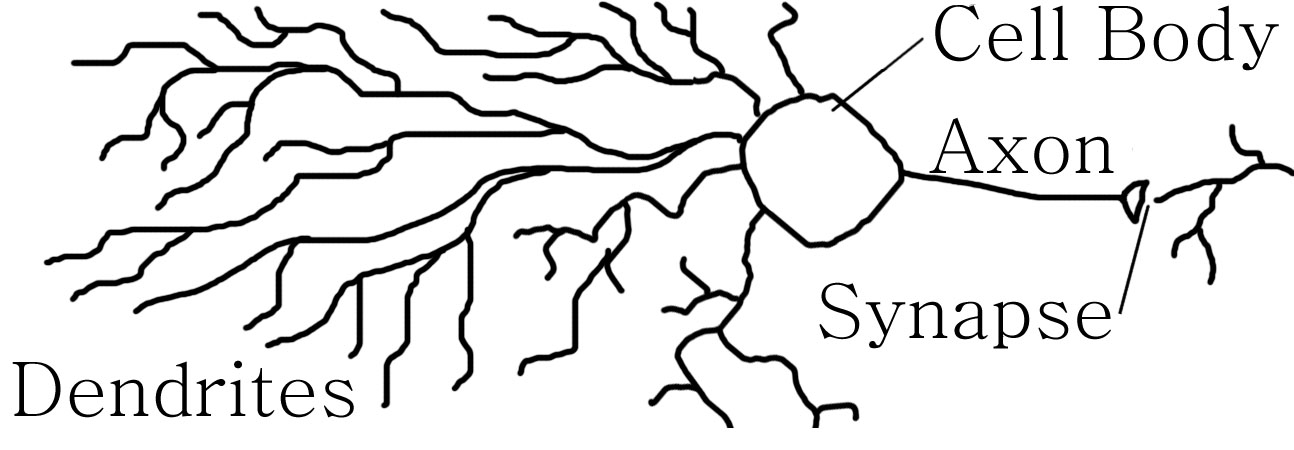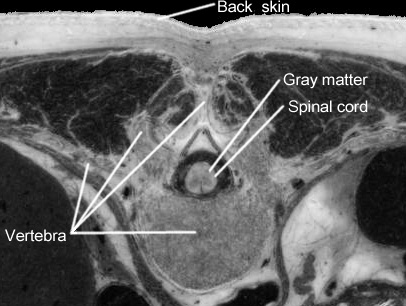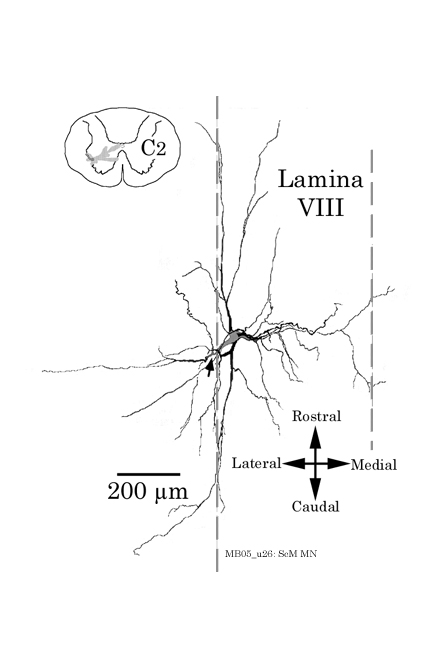

Gray matter in the spinal cord may be a part of the human mind. Did you know that there is gray matter in the spinal cord? Gray matter is the substance that makes up the thinking part of the brain; it extends down the entire length of the spinal cord, to the waist. The business of gray matter is to process information. The physical basis of mind has been debated for centuries; in these debates, people tend to underestimate the contribution that the spinal cord makes to the mind. The gray matter in the spinal cord receives information from the senses, including information about where we are in the world. Much of our knowledge about orientation is processed in the gray matter of the spinal cord, and contributes to mind on the subverbal level. Some sort of intelligence runs down the middle of the human body. There is mind in the spine.

Figure 1. A typical neuron with dendrites, cell body, and axon.
© walatka
The dendrites receive signals from other neurons and pass them into the cell body. If a threshold is reached, the cell body sends a signal down the axon. At the end of the axon is a tiny space (synapse), across which the signal is transmitted to a dendrite of the next neuron.
All neurons have these basic components. Some neurons have very long axons, made for transmitting signals over long distances. For example, some axons go all the way from the spine to a toe, an amazing length for a cell. Long axons are coated with myelin, a white sheath of fatty cells that promote the rapid and consistent propagation of the traveling signal; that is, the white myelin helps the axons transport signals over long distances. Myelin-coated axons, when massed together, make up what is known as the white matter. In the brain or the spinal cord, a group of neurons working to transport signals is called a tract, and signals travel efficiently in the tract because of the white myelin. The signals are information; white matter transports information.
Other neurons have short axons and many, many dendrites. Sometimes thousands of dendrites. The short axons are not covered with myelin. Thus, these neurons are gray. When massed together, they form the gray matter. See Figure 2.

Figure 2. Gray neurons have shorter axons and more dendrites. © walatka
The "gray" neurons actually are not gray in living tissue but look gray in a cadaver. The "gray matter" is perfused with blood in living tissue, making it more a pink or beige color. The gray neurons specialize in processing information. The job of the nervous system is to transport and process information from inside and outside the body. Sensory receptors pick up the information. The sensory receptors are attached to long-axon neurons, which send signals to the gray matter of the central nervous system (the brain and the spinal cord). The gray matter receives the information signals. Billions of signals come in. The dendrites sort out the signals, depending on where they are coming from and how fast, and cause the cell body to send a signal down the axon, or not. Exactly how these little gray cells do their work is not yet known. When the gray matter has decided what to do with the information, it sends signals back out to the body.
REVIEW: White matter has tracts (channels) which carry information from one place to another within the nervous system. Gray matter is for processing information. This is standard biology.

Figure 3. Photograph of a cross-section slice through the body,
a few inches above the waist, showing the spinal cord within the
vertebra, and the butterfly shaped gray matter within the spinal
cord. Approximately actual size. Slice #550, courtesy of the
National Library of Medicine, NPAC, and OLDA.
The job of the gray matter is to receive information and decide what to do with it: ignore it or send it on to other neurons, send out instructions to be relayed to other parts of the body, or synthesize the information and create new information. As you are walking along, the spinal gray matter receives information about where your legs are, what they are doing, and where the ground is. For every step you take, the spinal gray neurons receive information, share the information with neighboring neurons, and send instructions to the leg muscles about what to do next. The billions of incoming impulses are synthesized into condensed, coherent information.
The spinal cord is often portrayed as a conduit of information to the brain, but the cord is much more than that. By definition, the brain is in the head. Anything below the skull is non-brain, but the gray matter in the spinal cord does a lot of brain-like work. Not algebra, but something more than merely passing information along.
Sigmund Freud established that the mind comprises more than conscious thinking. In Freud's scheme, the mind includes several levels: conscious, subconscious, and unconscious. It could be said that there is a subverbal level of mind, a level that lays the foundation for conscious thought, with information that has not been put into words or symbols, but is information none-the-less. The spinal cord contributes to mind on the subverbal level. Zen meditation is the practice of paying attention to subverbal information; one focuses one's mind on the sensations of breathing, without putting words on the sensations. You let your mind be full of subverbal awareness. That is, subverbal information can be part of the conscious mind. Not everything that we think needs to be formed into words. We can be aware of more than words. The concept of being "centered" is rooted in subverbal awareness of the lower body.
The spinal neurons are intimately interconnected with the brain neurons. The spinal cord passes information to the brain, but not raw unfiltered information. The spinal cord gray matter edits the information, thereby making a contribution to mind.
Dr. Inder Perkash, PVA professor of spinal cord injury medicine at Stanford University, and chief of the Spinal Cord Injury Service in the Veterans Hospital in Palo Alto, California, continues this theme; he told me that he encourages his patients to develop their "spinal brains." Perkash said, "The idea of a mind in the spinal cord does make sense to me in light of my experience with spinal cord injury patients. My patients learn to use the mind in their spinal cords to improve musculo-skeltal function."
Scientist Paul Davies takes the theme several steps further; in a lecture at NASA Ames Research Center, he said that the life itself is an extraordinary information processor. "Every living cell is a fantastic supercomputer."
There could be a lot of interesting stuff going on in those little gray cells in your spinal cord.
In The Biological Basis of Mental Activity, Professor John I. Hubbard says, "The biological basis of mental activity may in one sense be described as the whole body." The McGraw-Hill Dictionary of the Life Sciences defines mind as "The sum total of the neural processes which receive, code, and interpret sensations, recall and correlate stored information, and act on it," which brings up the question, does the spinal cord store information? Does the spinal cord learn? William R. Uttal, in The Psychobiology of Mind, says, "learning and memory seem to be a generalized property of all nervous tissue. ... All in all, it is clear that some forms of learning can be mediated at the level of the spinal cord. ... learning is an ubiquitous feature of almost any nervous tissue, even regions such as the spinal cord."

Figure 4, Image of an actual neuron from the gray matter of a
spinal cord.
Light microscopic reconstruction from 60 micrometer serial sections using a camera lucida of an antidromically identified sternocleidomastoid motoneuron in the squirrel monkey; the motoneuron was intracellularly labeled with biocytin and later visualized using immunohistochemical techniques. Courtesy of Richard Boyle, Director of Center for Bioinformatics, NASA Ames Research Center. 1997